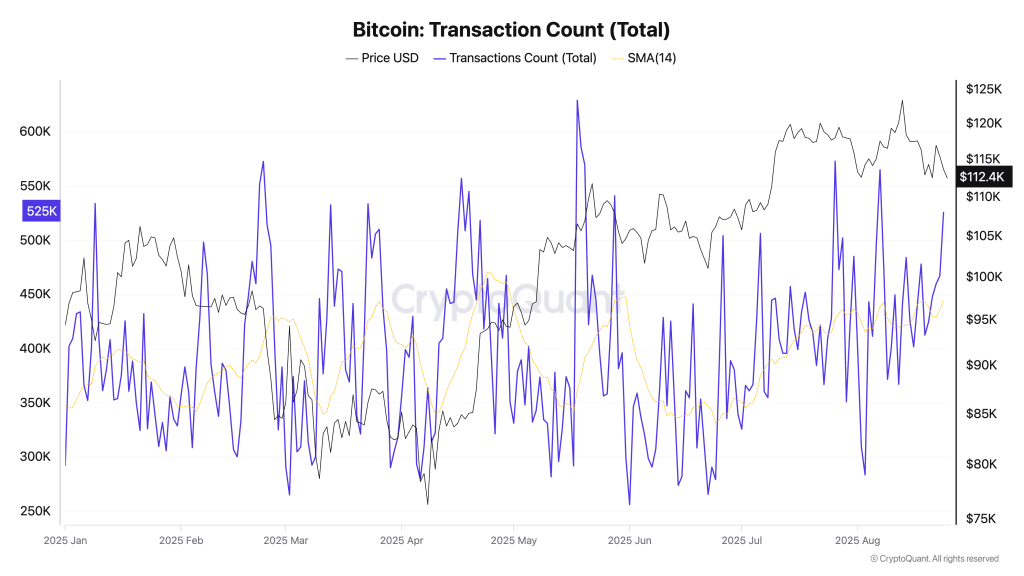Bitcoin’s on-chain data shows a rise in daily transactions, a small decline in active wallets, and a drop in the total tokens moved on-chain, a pattern consistent with more frequent, smaller transfers concentrated among a narrower set of participants.
Data from CryptoQuant showed that, in 2025, mean daily transactions were 394,382, and the last 30 days averaged 439,534 (+11.45% versus the full-sample mean), while mean tokens transferred fell from 630,383 to 588,180 in the same window (−6.69%). Active addresses moved slightly lower, with a full-sample mean of 945,752 and a last-30-days mean of 928,141 (−1.86%).
Price behavior diverged from raw transfer value: the mean close across the period was $100,627.93, and the last 30 days averaged $116,537.17 (+15.81%), even as reported daily volume averaged $28.46 billion for the full sample and $23.92 billion over the recent 30 days (−15.96%). Those figures describe a market where more on-chain events are occurring, but each event is, on average, smaller in token value and concentrated among fewer actors.
This combination of higher transaction frequency, lower tokens per transaction, and fewer active addresses points to operational activity rather than a distributed resurgence of retail participation. Custodial flows, exchange batching, internal rebalances, and programmatic settlement can all elevate transaction counts without increasing the count of unique wallets or the aggregate token value moved.
When large on-chain transfers cluster, they distort headline token-flow metrics and can mask the underlying microstructure: median tokens per transaction fell in the recent window, confirming that the incremental transactions are smaller on average. That reduces the visibility of true liquidity at scale because many small transfers do not substitute for large block trades or settlement-sized flows that underpin deep order books.
At the same time, price has moved materially higher: Bitcoin saw a 21.7% YTD increase, while transactions rose about 68.3% and tokens moved fell roughly 29.6%. Price appreciation with lower reported volume suggests demand was concentrated, either coming via off-chain mechanisms (OTC, block trades) or handled by a small number of large counterparties whose on-chain settlement does not register as broad turnover.
Correlation analysis supports the same reading. Since the beginning of the year, the Pearson correlation between price and transaction count was weakly positive (r ≈ 0.09) and between price and tokens transferred nearly flat (r ≈ 0.03), while reported volume had a modest negative correlation with price (r ≈ −0.23). In the last 30 days, the active-address/price relationship strengthened (r ≈ 0.36), which indicates short windows when reactivation of users aligns with price moves. However, those pockets are exceptions inside a larger pattern of concentrated operational flows.
This data shows that liquidity is less fungible than headline metrics imply: many small transfers do not equal available execution size at given prices. Second, episodic large transfers create tail risk; a single large withdrawal from an exchange or custodial reshuffle can produce abrupt price moves if on-exchange liquidity is shallow. Third, using tokens-per-transaction and value-band decomposition (<1 BTC, 1–10 BTC, >100 BTC) changes the signal-to-noise ratio: the decline in large-value transfers is the primary driver of falling tokens moved, not weaker use overall.
The post The hidden signal in Bitcoin’s 439k daily transactions and falling big trades appeared first on CryptoSlate.



